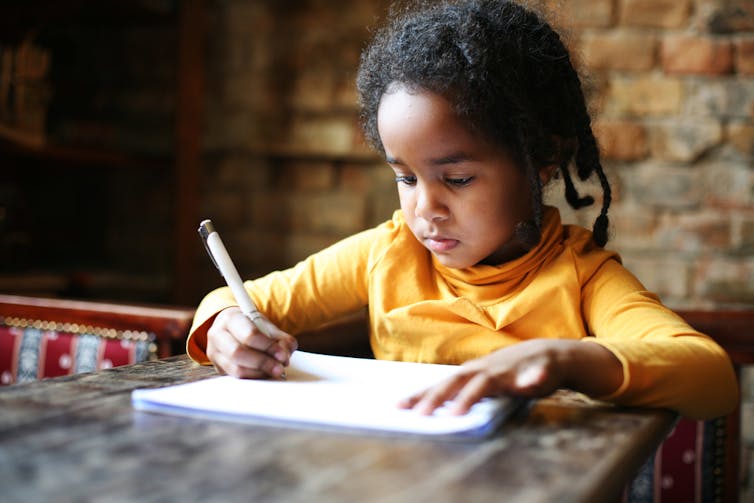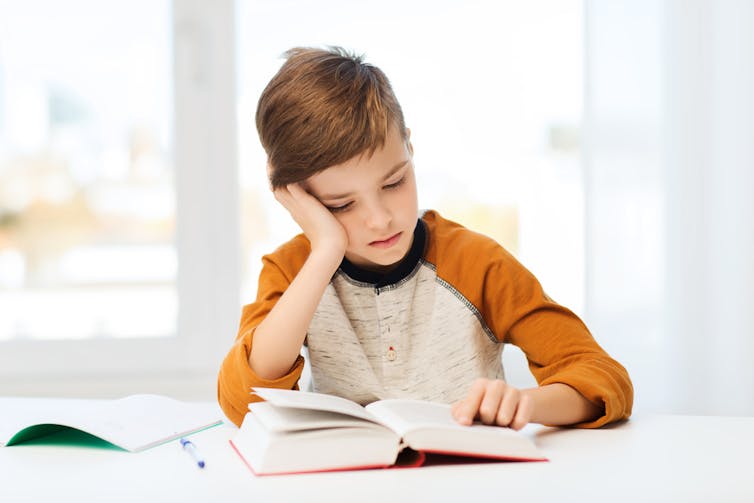
Ear infections are the number one reason for preschool children to visit the GP. Ear infections can be painful, cause difficulty with balance and can also lead to temporary hearing loss.
Most parents assume that there will be no long lasting effects once an ear infection clears up – and most of the time this is true. But in some cases, children can become permanently deaf after repeated infections – which is also known as “glue ear”.
It seems that repeated ear infections can also increase the risk of reading difficulties – as our recent study shows. We found that a third of children who had repeated ear infections had reading difficulties at age nine.
In another group of children, we also found that a quarter of children with reading difficulties in year four of school had some degree of deafness that their parents and teachers were not aware of.
The link between hearing and reading
Most children who have reading difficulties are not deaf or hard of hearing – but there is a significant overlap.
This is because learning to read builds on a child’s existing knowledge of language. So children who can’t always hear speech well can find it harder to work out how spoken words “map” onto printed words.
In this way, learning to read can be difficult for children who are deaf. Even mild deafness can have a big impact on hearing. And children with mild or moderate deafness can also have trouble understanding conversation in busy environments – like the classroom.

That said, the link between hearing and reading difficulties isn’t inevitable – not all deaf children struggle to read. This is because learning to read involves the combination of many different skills – such as understanding the link between letters and speech sounds, knowledge of grammar, memory for spelling patterns and the use of context. And all of those skills can help children to learn to read and write effectively, even if they do initially have difficulty.
Testing times
All newborn babies have their hearing screened in the UK, and the government’s “healthy child” policy also recommends hearing screens when children start school.
These policies have dramatically increased early identification for deaf children. But school entry hearing screens are not offered in all areas of the UK. And because of funding cuts, services are even being withdrawn in some places.

When you consider that around half of the 50,000 deaf children in the UK were not born deaf but lost their hearing during childhood, it is easy to see how these children – with mild, fluctuating or acquired deafness – can be missed by existing screening procedures. And this of course then makes them more at risk of poorer literacy outcomes.
Supporting reading
It is clear then that children who have difficulty learning to read should have current and past hearing test results taken into account. These children should also be reassessed where appropriate, so that both doctors and teachers – as well as parents – can work together to help that child.
This is important, because children who have had a lot of ear infections have been found to have very specific difficulties with perception of speech sounds. And in most cases, other reading and spelling related skills are not impaired.
What this means, is that parents and teachers could not only provide extra support to help these children understand the links between letters and sounds, but they can also use those other skills to support their reading – enabling them to reach their full potential.
Dr Helen L Breadmore has received funding from The Nuffield Foundation. The Nuffield Foundation is an endowed charitable trust that aims to improve social well-being in the widest sense. It funds research and innovation in education and social policy and also works to build capacity in education, science and social science research. The Nuffield Foundation has funded some of this research, but the views expressed are those of the authors and not necessarily those of the Foundation. More information is available at www.nuffieldfoundation.org
This article was originally published on The Conversation. Read the original article.







